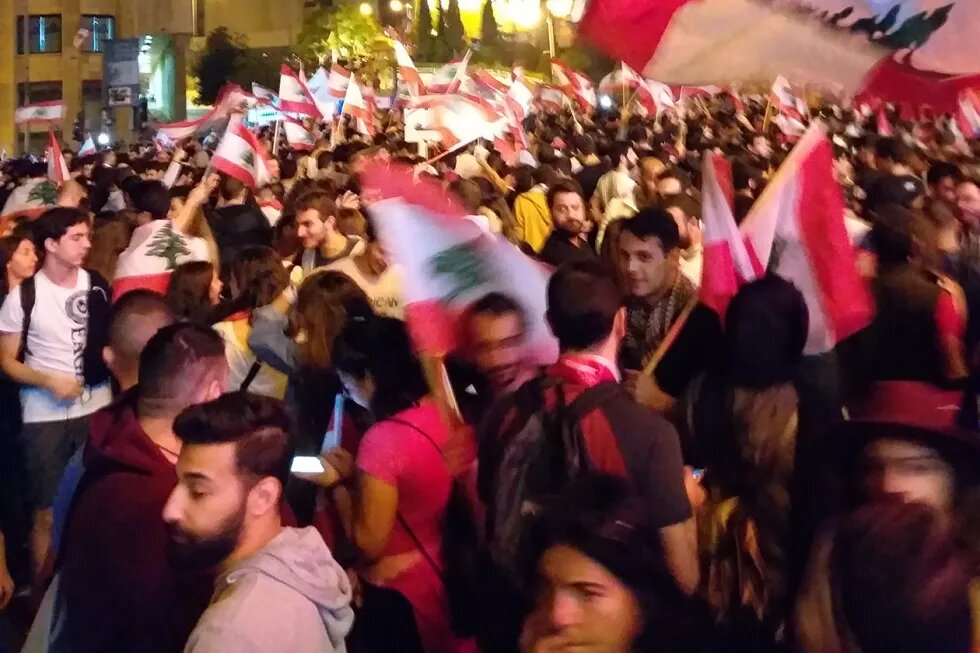Angry Lebanese crowds took to the streets on the 17th of November after the authorities had failed to contain wildfires in more than a 100 locations in Mechref and Chouf due to the lack of fire-fighting helicopter maintenance. This came on top of the mounting crises that the country had witnessed recently, namely, shortage of dollars in the market, fall in the value of the local currency, disruption in fuel distribution, and –to top it all- the levying of a monthly tax on a supposedly free application, WhatsApp.

Angry Lebanese crowds took to the streets on the 17th of November after the authorities had failed to contain wildfires in more than a 100 locations in Mechref and Chouf due to the lack of fire-fighting helicopter maintenance. This came on top of the mounting crises that the country had witnessed recently, namely, shortage of dollars in the market, fall in the value of the local currency, disruption in fuel distribution, and –to top it all- the levying of a monthly tax on a supposedly free application, WhatsApp.
Hundreds of thousands of people, more than one million according to some estimates, flooded public squares in what was marked as the largest protest in the history of the country. Lina Khatib of Al Jazeera English argues that in contrast to the 2005 Cedar Revolution in which support was split along the political and religious divide in Lebanon, the current movement represents groups from all over Lebanon irrespective of the various sects. Accordingly, Khatib rightly views the protests as an "existential threat" to the Lebanese government and a "revolution".
The protests are now in their second week and have already caused shock waves in the country. Top leaders have been trying to come up with solutions to meet the demands of the protestors. On the third day, Prime Minister Saad Hariri after a long meeting with his Cabinet announced a set of financial and economic reforms in the hope that this would calm the streets and put an end to the demonstrations. However, his speech alienated the protestors further and they insisted on the resignation of the cabinet. Intense skepticism was sounded by the protestors, who accused the politicians of planning to get them out of the streets through vague promises. In fact, the reform items proposed by the prime minister were viewed by the protestors as an admission of failure and corruption by the same politicians (or their sons respectively) who have been in charge of the country for about thirty years. For his part, the president of the republic, Michel Aoun, following a whole week’s silence made a brief address to the nation, in which he called on the protestors to meet him for dialogue. Right after that, Hassan Nasrallah, leader of the Hezbollah Party also addressed the protestors accusing them of receiving funds from foreign embassies and clearly announcing his opposition to the downfall of the President, the Government and the Parliament. The protestors were as unimpressed with his speech as they had been with that of Hariri and Aoun.
According to the Daily Star “Hariri’s option to quit is off the table for now since he and several major parties feel it would plunge Lebanon deeper into crisis at a dangerous time and his coalition partners have approved reforms he announced Monday”. In the opinion of a former minister, “the real problem is that you cannot bring any prime minister other than Saad because there is no [other] Sunni to parachute now and he is the only one who has international support.”. Yet most demonstrators are demanding not only the resignation of the prime minister, but also that of the whole parliament and its speaker and even the president of the republic.
Another solution that has been discussed among the main parties is the reshuffling of the cabinet, leaving Saad Hariri as prime minister but replacing controversial ministers with technocrats who are believed to be better qualified to implement the reforms suggested. Mohanad Hage Ali of the Carnegie Middle East Center said: “The more likely scenario is there might be some ministerial change ... to remove some of the figures who are quite unpopular.” This, however, is unlikely to satisfy protestors, who know that the decisions would remain in the hands of the dominant political parties.
But what next? The first nine days of the protest have resulted in some concessions by the politicians, but have fallen short of the expectations of the protestors. This has resulted in deadlock. Obviously, the status quo cannot go on for much longer especially as the closure of roads continues. An inception of a second phase of this movement is only to be expected soon. Will the protestors give up some or all of their demands, and how? Could the army intervene to break up the demonstration or would the politicians give further concessions? None of these scenarios seems likely at the moment. The more probable scenario is frightening. Opponents of the protesters may want to create a counter movement, and some are already hinting at bloodshed in the streets. This notwithstanding, there are some positive indicators. The protests so far have been largely peaceful—a great achievement given that in Iraq scores of people died in one day. Moreover, there has been increasing speculation that there is indeed an emerging leadership of the protestors and that they have already made undisclosed contacts with some government officials.
Given this extremely complex situation, one can only hope that Lebanon be spared the worst if not aspire for the best. Can this be also a threat to the political elite?